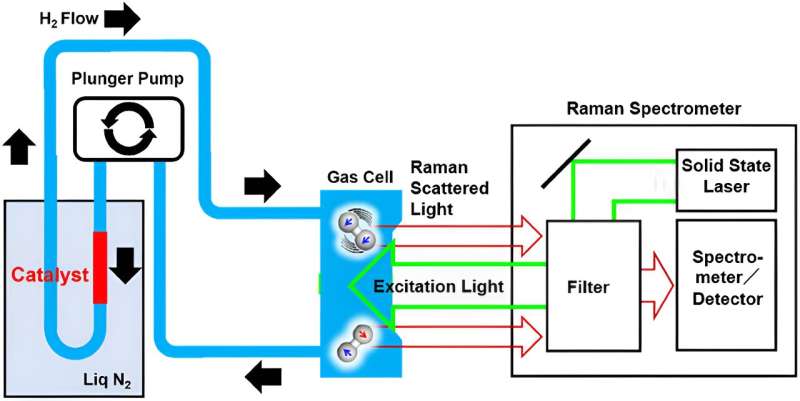This article has been reviewed according to Science X's editorial process and policies. Editors have highlighted the following attributes while ensuring the content's credibility:
fact-checked
trusted source
proofread
Researchers identify materials capable of catalyzing the conversion of ortho-hydrogen to para-hydrogen

A research team consisting of NIMS and the Tokyo Institute of Technology has identified materials capable of catalyzing the conversion of ortho-hydrogen to para-hydrogen. These catalysts should be essential to the spread of mass-transportation/storage of liquid hydrogen. The research is published in the journal Exploration.
Hydrogen is becoming widely accepted as an alternative energy source to fossil fuels. Its liquefaction (at temperatures below -253°C under pressures higher than one atmosphere) can dramatically reduce its volume, making it suitable for transportation and storage. Hydrogen molecules (H2)—each composed of two hydrogen atoms—exist in two isomeric forms: ortho- and para-H2.
Under normal conditions, ortho- and para-H2 are present in a 3:1 ratio, with ortho-H2 slightly more energetically unstable than para-H2. Gradually cooling H2 to its liquefaction temperature causes all ortho-H2 to convert to para-H2, producing stable liquid H2.
Rapid cooling of H2 under high pressure—needed for liquefaction—delays the ortho-to-para conversion during the cooling process, leaving considerable amounts of ortho-H2 in the liquid H2 produced. The residual ortho-H2 molecules continue to isomerize to para-H2 during the storage, triggering partial vaporization of the liquid H2 and resulting in significant loss of H2 and energy.
The choice of proper catalysts prior to the liquefaction process can solve this problem because of accelerated ortho-to-para conversion. However, existing catalysts were incapable of adequately accelerating conversion and it was therefore desirable to develop more effective ones.
This research team evaluated the ability of more than 170 solid materials—including metals and ionic crystals—to catalyze ortho-to-para conversion. The team found that manganese oxide (Mn3O4) and cobalt oxide (CoO) exhibited significantly higher catalytic performance than conventional iron oxide-based catalysts. In addition, the team identified major factors influencing the catalytic activities of these materials in accelerating ortho-to-para conversion.
Hydrogen liquefaction is crucial for long-distance hydrogen transportation by sea from major hydrogen producers/exporters (in particular, Australia and the Middle East) to hydrogen importers, such as Japan.
The catalyst design guidelines and high-performance catalysts developed in this research project are expected to greatly help Japan move forward with its plan to put the hydrogen economy concept into practice.
More information: Hideki Abe et al, Exploration of heterogeneous catalyst for molecular hydrogen ortho‐para conversion, Exploration (2023). DOI: 10.1002/EXP.20230040
Provided by National Institute for Materials Science





















